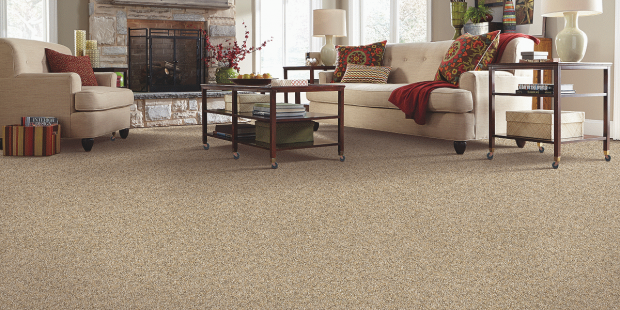How to Kill Germs in Carpet to Reduce Your Family’s Risk of Illness

Originally published by Mohawk Flooring
At this very moment, everyone around the world is practicing responsible social distancing in a collective effort to prevent the spread of germs. Although these times can feel uncertain and create anxiety, for most it is reassuring to digitally connect with friends and family and safely quarantine in the comfort of your home.
How are you passing the time together as a family? Maybe you’re letting the kids learn a few new meals and try their hand as cooks in the kitchen. Perhaps you’re planning new home improvement projects together and taking everyone’s vote! You are most certainly watching movies, Netflix, Disney+, and taking turns holding the remote.
During this time, it’s important to prevent bacteria and germs from lingering on surfaces and floors. With often touched objects in your home like door knobs and appliances, it’s easy to disinfect them with certain approved chemical sprays and wipes, but many people are starting to ask: how do we reduce our family’s risk of illness if we have soft carpet in our homes? The following steps will help you clean your carpet and kill germs as part of a greater effort to disinfect your home and protect your loved ones.
Can Carpet Make You Sick?
Soft carpeting is cherished for its warmth, cushion, and luxurious feel underfoot. As you watch your family spend time together watching TV, reading, playing with pets, and playing with puzzles, games, and toys, it’s great to know there’s a soft landing place for every kind of activity.
However, if your carpet isn’t regularly and properly vacuumed, then dust, dirt and pet dander may accumulate in your carpet. Also, in all homes it’s possible for germs to linger on surfaces. So while carpet itself will not make you sick, it’s important to keep your carpet clean, and if you are worried about germs, you’ll need to add the additional step of disinfecting your carpet per instructions below from the CDC. Let’s start with the multiple methods of cleaning your carpet.
Select the Right Vacuum CleanerWhen it comes to choosing the right vacuum for your carpet, you can’t just select from a leading vacuum brand and assume that it will be the best at removing dirt and dander. Just because a high-end model has superior suction power or functions as a robotic vacuum cleaner, that does not mean it will be most effective. Vacuum cleaners that are not adjustable to accommodate different carpet heights are not recommended.
Always look for a vacuum cleaner that is certified by the Carpet and Rug Institute (CRI) Seal of Approval/Green Label Vacuum Cleaner Program when purchasing a new model. If you like the current model you own, just make sure that it is a good match for your carpet to create the most effective airflow. Here are some key points to consider when selecting the right vacuum cleaner:
- Vacuum Height – Adjustable height is the most important feature. A vacuum set too high above the carpet surface won’t get to the gritty soil and debris below. A vacuum’s beater bar or brushes can “fuzz” the carpet’s surface if the setting is too low. Your ideal height setting for airflow is based on pile height and fiber type. High pile and premium soft carpet require higher settings, while thick loop, casual frieze, or long pile carpet may require suction only. Use carpeting in your closets to perform test runs.
- Suction Type – Extreme suction power does not ensure effective removal of dirt and debris and can even cause damage to the carpet. Avoid concentrated or sealed suction for high pile, premium soft carpet.
- Beater Bar/Brushes – A vacuum with a rotating brush or beater bar should just lightly touch your carpet surface. This will prevent damage to your carpet and create better airflow based on your carpet’s specific pile height. With some wool loop berber carpets, we recommend disengaging the beater bar entirely.
One of the biggest benefits of Mohawk’s innovative Air.o Hypoallergenic Soft Flooring is that the unique, unified construction provides better airflow, releasing more dust and dirt with each vacuum than carpet with traditional padding. Carpet acts as a passive air filter, trapping dust, pollen, and dander from the breathing zone. Air quality will improve when your Mohawk Air.o Hypoallergenic Soft Flooring is combined with a great vacuum model match such as the SONICLEAN SFC-7000 SOFT CARPET UPRIGHT VACUUM.
During this time with all of the family indoors, it’s wise to vacuum high-traffic areas daily with slow, repetitive motions that overlap. Vacuum medium-traffic areas twice per week, and vacuum all areas in the home with carpet at least once per week, right up to the edges where debris and pet hair can accumulate. A full list of CRI-certified vacuum cleaners is available on the Carpet and Rug Institute website.
How to Remove Carpet StainsAs your family spends extra time indoors and on your carpet, it’s more than likely that something will get spilled on it at some point. In these instances, you will be incredibly grateful if you covered your living room, family room, or bedrooms with the unbeatable spill protection of SmartStrand carpet. These fibers are engineered with 100% permanent, inherent stain resistance that won’t wear or wash off now or in the future! Also, the advanced Nanoloc™ Spill and Soil Shield makes carpet three times easier to clean, meaning you can remove spills and stains quicker than most other carpets.
When spills do occur on your carpet, there’s no need to stress: Act promptly and use appropriate cleaners to clean the spills, stop stains from ever forming, and prevent moisture absorption into the carpet. For the best results, you should first try removing the stain with warm water before using a cleaning product. Starting from the outside of the stain to prevent spreading, use a spoon or dull knife to remove any solid material. Then blot up liquid with a white towel or paper towels, and try removing the remaining stain with warm water. No matter what, do not use any cleaner with a pH of 10 or higher.
If you still need to use a cleaner to completely remove a stain from your carpet, it’s extremely important to determine what type of stain you have to match the perfect cleaner. The typical stains that your home is likely to see include common water-based stains (beer, juices, candy, food, marker), special water-based stains (soda, wine, liquor, watercolor paint, soil), greasy, oil-based stains (chocolate, peanut butter, gum, glue, crayon), and a separate special category of water-based stains comprised of coffee, tea, and pet urine.
Once you have identified what type of stain you have using our Common Stains Chart and the coordinating Stain Removal Procedure, you can use the recommended gentle DIY cleaning solution to remove the stain and disinfect that area of your carpet. To create these solutions and be ready at a moment’s notice, you should keep the following ingredients and items available in your pantry: clear hand dishwashing detergent, absorbent white towels or paper towels, non-bleaching, non-sudsing household ammonia, and white vinegar. Closely and slowly follow the stain removal technique outlined above for your specific type of stain for the best results!
Cleaning Your CarpetOne of the most effective methods for thoroughly cleaning soft carpet is professional hot water extraction using cleaning products, equipment or systems that carry the CRI Seal of Approval. Mohawk’s carpet warranty requires professionally cleaning at least every 18 months, and if you have a full household at all times, with kids and pets that go outside every day, you will want to stay closer to a 12-month time frame. Periodic cleaning by a certified carpet-care professional will not only help keep your carpet healthy, it will also refresh your carpet’s appearance.
Having your carpet professionally cleaned is a great step as part of a plan to disinfect your home, but it is not the final step. To kill germs, you’ll need to chemically disinfect your carpet afterward.
Disinfecting Your CarpetAfter thoroughly cleaning your carpet, we recommend following the household cleaning guidelines by the Centers for Disease Control for up-to-date information on how to disinfect your home, including soft or porous surfaces like carpet. Remember to always test disinfectants in an inconspicuous area before using.
Without a doubt, the more effectively that you can get dust, dirt, and bacteria out of carpet, and kill germs that might linger, the better. Here’s a chance to establish cleaning routines with your family and get everyone involved. You can even create rewards with screen time and special sweet treats after chores are completed. The consistency you create in cleaning and disinfecting your home will make the process quicker and more effective.

